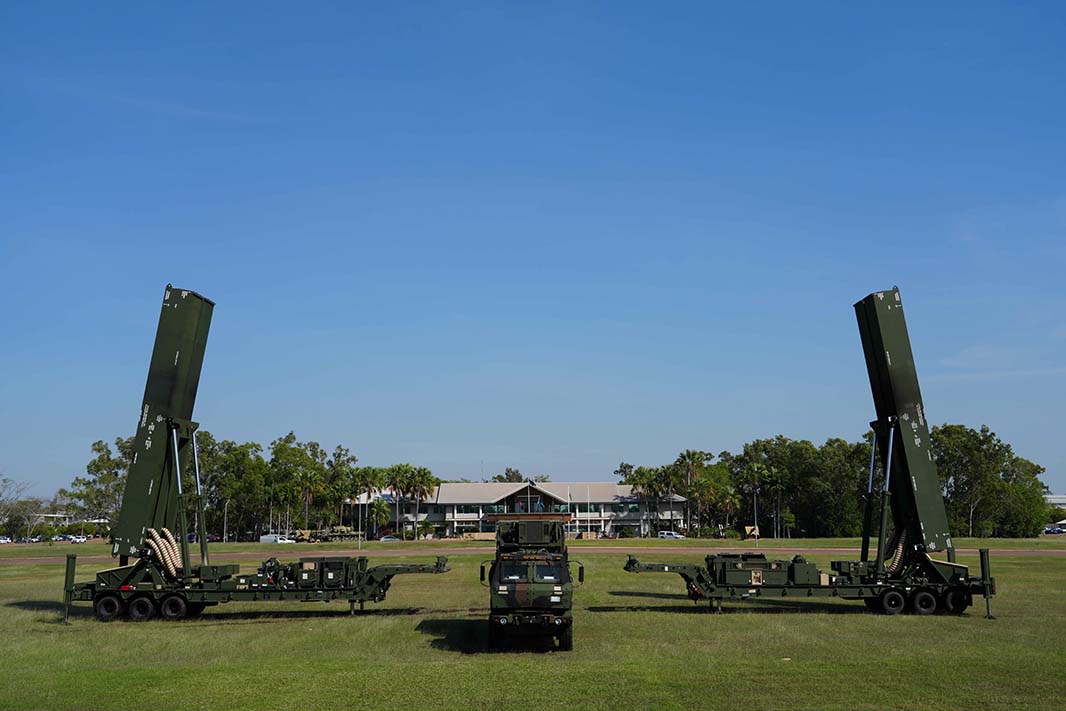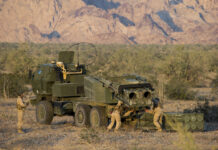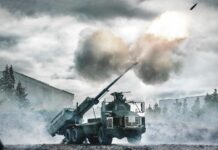The Indo-Pacific’s vast distances and China’s growing A2/AD capabilities demanded a new kind of military unit. Aimed at meeting this challenge, the US Army’s Multi-Domain Task Forces (MDTFs) represent a new paradigm in US military thinking. This deep-dive analysis examines the nine key systems that will enable these experimental units to project power across vast distances and multiple domains simultaneously.
In 2016, Admiral Harry Harris was in command of what was then the US Pacific Command (USPACOM); it changed to the Indo-Pacific Command (INDOPACOM) in 2018, the largest of the US’s combined combatant commands. Harris was responsible for more than 360,000 service personnel and an area of operations that covered 52% of the Earth’s surface.[1] A decorated and experienced pilot, he had assumed command of the US Pacific Fleet in 2013 and became Commander USPACOM in 2015. At the time, he was public about the threat posed by North Korea, but during his time as Commander, he had also witnessed a change in the US Department of Defense’s (DoD’s) approach to China. The 2016 annual Pentagon report to Congress on the development of the People’s Liberation Army (PLA) stated that the number of intercontinental ballistic missiles was increasing and so was their range.[2] China was modernising its submarine force, and at that time its production of surface combatants was beginning to gain speed.
China had 300 surface vessels when the Pentagon report was released in May 2016, making it the largest navy in Asia. To make matters worse for the US, the PLA Navy (PLAN) was busily retiring legacy vessels in favour of its new guided missile destroyers with their multi-purpose launch cells and anti-ship cruise missiles. It had not yet surpassed the US in terms of vessel numbers, but was on the way. The report also established that China was now a pacing threat, marking a shift from the language used in 2014 and 2015. So, with all this in mind, Adm Harris dialled into the Association of the United States Army (AUSA) Conference in October 2016 using Skype.[3] Harris did not mince his words, and emphasised that North Korea had recently conducted a nuclear test, the only country to do so this century. Russia and China had developed extensive anti-access and area denial (A2/AD) capabilities that were genuinely capable of holding US ships and aircraft at risk at extreme ranges. Four of the five significant risks to US security were in the PACOM area of operations.
“I’m already on-the-record for saying that our security environment now, and in the future, will require all the Services to exert influence in non-traditional domains,” Harris told the audience. “That means the Army’s got to be able to sink ships, neutralize satellites, shoot down missiles, and hack or jam the enemy’s ability to command and control its forces,” he explained.[4] An interesting statement for a force that was repositioning itself after more than a decade fighting non-state actors. Harris went on to discuss “path dependency”, a concept that explains how decisions made in the past can constrain or influence decisions and outcomes in the present and future. The US forces had to break their path dependency, and do it quickly.
Harris challenged the assembled audience of US Army personnel, stating: “Before I leave PACOM, I’d like to see the Army’s land forces conduct exercises to sink a ship, shoot down a missile, and the aircraft that fired that missile…near simultaneously…in a complex environment where our joint and combined forces are operating in other domains.” He had certainly set down a gauntlet for them. “I don’t have a whole lot of time left at PACOM. Good luck,” he concluded.
Perhaps, somewhat surprisingly, the US Army would achieve a lot of what he challenged them to do. Adm Harris moved on from PACOM in May 2018, handing over to Adm Philip Davidson. By that time, the US Army had set up the Multi-Domain Task Force Pilot Program (MDTF-PP), an experimental unit based on the 17th Field Artillery Brigade with an intelligence, information, cyber, electromagnetic warfare, and space (I2CEWS) capability integrated into its existing fires command structure.[5] During the Rim of the Pacific Exercise (RIMPAC) in August 2018, the US Army sank a ship with a Naval Strike Missile fired from an M1075 palletised load system truck.[6] A Dismounted PATRIOT Information Coordination Central (D-PICC) unit (a C2 node for PATRIOT air defence batteries) provided air defence in support of the experimental unit. Using Link 16, the MDTF-PP was connected to several different air defence sensors and able to engage both an aircraft and the simulated missile that it launched.[7]
It’s not clear if the MDTF managed to achieve all of this simultaneously, but RIMPAC was enough of a success for the US Army that as the MDTF-PP came to an end in October 2019, the Army already had plans to establish three more based on the lessons from the pilot. “US Indo-Pacific Command is making the Army’s MDO efforts its foundational concept as it develops its own joint warfighting concept for the region,” the INDOPACOM press release announcing the decision explained.[8] With that, the US Army’s MDTFs were born and efforts started to equip them. They are now starting to show their strengths, with another SINKEX conducted during Talisman Sabre 2025; only this time it was an SM-6 launched from a Mid-Range Capability Launcher with support provided by the US Marines. A Long-Range Hypersonic Weapon launcher was also displayed during the exercise, drawing the ire of various Chinese academics.[9] Despite the focus on the missiles deployed by the MDTFs, there are actually nine key capabilities that underpin their warfighting capacity and they start with reconnaissance.
Long-range strikes need long-range reconnaissance
![US Army Sgt Edward Dorba and Sgt Matthew Palombo, both electromagnetic warfare specialists assigned to 2nd Multi-Domain Effects Battalion, 2nd Multi-Domain Task Force, ensures an aerostat aircraft successfully launches in a field in northwest Poland, 31 August 2023. [US Army/SSgt Ashley M. Morris]](https://euro-sd.com/wp-content/uploads/2025/09/Intelligence-information-cyber-electromagnetic-warfare-and-space-capabilities-I2CEWS-Kopie-1024x683.jpg)
- Intelligence: The collection and analysis of information.
- Information: Shaping the information environment to influence adversaries and friendly forces.
- Cyber: Offensive and defensive operations in cyberspace.
- Electronic warfare (EW): The use of the electromagnetic spectrum to attack or defend assets.
- Space: The use of and ability to deny adversaries the use of assets in space.
Some aspects of their role were revealed during Vanguard 24, an exercise conducted in October 2024 by the MDEB from the 3rd MDTF. The unit focused “on integrating cyber, electronic warfare, extended range sensing and data transfer. The distances between training areas and teams replicated the distances required to operate in the Indo-Pacific Command theater, where 3rd MDTF is assigned”, the US Army explained.[10] “My team was able to effectively locate signals of interest, aggregate the sensor data, pass it back to the MDEB tactical command post at Fort Huachuca, then integrate the data into mission command systems to include the Army Intelligence Data Platform (AIDP), and send the data to the TF level All Domain Operations Center back in Hawaii,” said MDEB Commander Lt Col Pablo Diaz. This indicates that the unit was working to locate signals of interest, which, given the A2/AD disintegrating role of MDTFs, suggests that they may focus on locating radars for some fire missions. The AIDP is currently based on a number of tools from Palantir that are designed to bring data from diverse sources together and fuse it into a single picture, providing insights on patterns and key elements of the data for the users.[11] It is accessed by intelligence personnel from across the US services.
The intelligence and reconnaissance of the MDEB isn’t all that the MDTFs draw upon. The Keen Sword exercise with Japan in January 2025 demonstrated the ability of a Virtualized Aegis Weapon System (VAWS) to provide fire coordination support to the 3rd MDTF. VAWS was used to provide digital fire control coordination across multiple platforms, which included the Advanced Field Artillery Tactical Data System, removing the need for the manual transmission of orders. The exercise was used to show that the MDTF could coordinate with allies, the Japanese Self Defense Forces, as well as naval forces to conduct and deliver simulated long-range strikes.[12] With that, however, there are three systems within the MDEB that are worth exploring in greater detail.
-
K1000 Ultra-long range endurance unmanned aircraft system
![A Kraus Hamdani Aerospace K1000ULE unmanned aerial vehicle operates in Aqaba, Jordan, 9 March 2023, during International Maritime Exercise 2023. [US Army/Spc Aaron Troutman]](https://euro-sd.com/wp-content/uploads/2025/09/K1000-ultra-long-range-endurance-Unmanned-Aircraft-System-Kopie-1024x576.jpg)
- Size: Length of 3.0 m (9.8 ft) and a wingspan of 5.0 m (16.4 ft).
- Range: Approximately 1,600 km (1,000 miles).
- Payload: Up to 2.5 kg (5.5 lb); it has a modular payload bay that can carry optronic day/infrared cameras, signals intelligence (SIGINT), and EW packages.
- Endurance: Over 24 hours, with a record flight of nearly 76 hours for its class.
- Manufacturer: Kraus Hamdani Aerospace.
The K1000 is a Class 2 ultra-long range endurance unmanned aircraft vehicle developed for persistent intelligence, surveillance, and reconnaissance (ISR) missions. It has electric motors and can be charged using solar power whilst in flight, extending its flight time. It is a prime example of the US Army’s rapid acquisition strategy, procured as a commercial-off-the-shelf capability to meet an urgent need for long-endurance ISR. The K1000 was first acquired and evaluated by the Army’s MDTF, which sought to quickly field cutting-edge technologies. The UAV has notably participated in the Army’s flagship Project Convergence exercises, where it demonstrated its ability to serve as a high-altitude, long-endurance airborne sensor. During these exercises, the K1000 transmitted targeting data directly into the Army’s network, connecting with systems like the Tactical Intelligence Targeting Access Node (TITAN) to accelerate the kill chain and support long-range precision fires.
-
High-altitude balloon
![US Army soldiers, assigned to Extended Range and Sensing Effects Company, 1st Multi-Effects Battalion, 1st MDTF, fill a high-altitude balloon, in support of Exercise Balikatan 25. [US Army/SSgt Brandon Rickert]](https://euro-sd.com/wp-content/uploads/2025/09/high-altitude-balloon-Kopie-1024x683.jpg)
-
Tactical Intelligence Targeting Access Node (TITAN)
![TITAN is designed to support the commanders of an MDTF in their target selection and engagement. It is the conduit through which intelligence from various sources flows. [US Army]](https://euro-sd.com/wp-content/uploads/2025/09/Tactical-Intelligence-Targeting-Access-Node-TITAN-Kopie-1024x630.jpg)
- Description: TITAN is a mobile ground station consisting of a truck and trailer. It has different variants, with the size dependent on the specific equipment it carries. Its primary function is to process and disseminate data, and receives intelligence from a wide range of long-range sensors, including space, aerial, and terrestrial assets. It uses artificial intelligence (AI) and machine learning (AI/ML) to process intelligence from numerous sensors and provide targeting information to battlefield commanders.
- Equipment: The system includes a truck-mounted mission module, a satellite communications link, and a trailer to carry generators and other equipment.
- Software: The software is designed to integrate data from all-domain sensors and apply AI/ML to produce intelligence that can be used for both lethal and non-lethal operations. This includes downlink stations for satellite imagery. In 2020, it was reported that the Maxar US Army Remote Ground Terminal (RGT) would be installed into the TITAN vehicles, providing access to MAXAR’s commercially available imagery as well as that of other suppliers as soon as it is available. It is unclear if this has been integrated into the vehicles delivered to the US Army.[14] Other reports indicate that of the two TITAN variants, one will also be able to directly access national level satellite assets.
- Manufacturers: Palantir is the prime contractor. Other companies involved include Northrop Grumman, Anduril Industries, L3Harris Technologies, and Raytheon.
From available information, TITAN is the glue intended to bring the MDTF’s reconnaissance assets under the MDEB, together with the kinetic strike systems under the Strategic Fires Battalion. It is positioned as a receiving point for many different types of sensor data with a particular focus on satellite reconnaissance. It also acts as a node to provide unclassified data to allies and partners. The TITAN programme began in 2021 with a competitive prototyping phase. In July 2022, the Army awarded separate contracts to Lockheed Martin and Palantir to develop competing prototypes. After the prototyping and evaluation phase, the Army awarded a USD 178 million contract to Palantir in March 2024 to continue developing and delivering ten TITAN prototypes, with an expectation of more deliveries in the future. The first vehicles were delivered to the 1st MDTF in 2025. The advanced variant is truck-based, employing the Family of Medium Tactical Vehicle (FMTV) fleet’s M1083, while the basic variant is mounted on a Joint Light Tactical Vehicle (JLTV). The differences between the advanced and basic variants are understood to be the types of data that they can receive. Advanced vehicles can reportedly receive classified sources of intelligence directly, without the need to reach further up the command chain.
The Father of All Monsters
A Typhon is not a typo, it is the name of a mythical fire-breathing giant and the deadliest monster in the entire Greek pantheon. Typhon was said to be so tall, his head touched the stars and he launched a battle against Zeus and ultimately lost. And through his partnership with another creature, Echidna, is said to be the father of all monsters. It is also quite fittingly the name given the Mid-Range Capability, which has been developed for the MDTFs. The Typhon launchers are one of three kinetic capabilities available to the commander of an MDTF and arguably the most mature in terms of their effectors.
The Strategic Fires Battalion is the coordinating organisation for the Father of All Monsters. It includes three batteries; the HIMARS battery, the Mid-Range Capability Battery, and the Long-Range Hypersonic Weapon (LRHW) Battery.[15] The capabilities are interesting from a number of perspectives, not least their range. The MDTFs are technically under the direct command of the geographic combatant commander, the intersection between political and military leadership, which is necessary their effects can be delivered across a theatre. In theory, this means they are an echelon above a corps.
While much of their concept of operations (CONOPS), particularly integration with a US Army corps, is being developed, it is clear that MDTFs are meant to be an enabler for the joint force. They are purpose-built to degrade and penetrate an adversary’s A2/AD capabilities in a given theatre. This likely means that a US Army corps commander would request capabilities from a supporting MDTF, and the Commander INDOPACOM would make the decision on whether or not to release those assets.[16] That said, it is not clear that the MDTF makes sense as an ‘above corps level organisation’, it would perhaps make more sense for them to be a divisional asset despite their strike range.
-
Dark Eagle (Long-Range Hypersonic Weapon (LRHW))
![The 3d Multi-Domain Task Force deploys the Long-Range Hypersonic Weapon System to Northern Territory, Australia, 9 July 2025, to participate in Exercise Talisman Sabre 25. Talisman Sabre 25 marks the first operational employment of the Dark Eagle west of the International Date Line and outside the continental United States. [US Army/Sgt Perla Alfaro]](https://euro-sd.com/wp-content/uploads/2025/09/Dark-Eagle-Kopie-1024x683.jpg)
- Size of launchers: The launcher is an M870A4 trailer, which is 18.2 ft (5.5 m) long and 8.3 ft (2.5 m) wide. It is pulled by an FMTV truck.
- Range of missiles: The LRHW has a reported range of 1,725 miles (2,776 km).
- Number of missiles per launcher: Each Transporter Erector Launcher (TEL) carries two missiles.
- Organisation of a battery: An LRHW battery consists of four launchers (eight missiles in total) and a Battery Operations Center (BOC) for command and control.
- Manufacturer: The missile component is being developed by Lockheed Martin and Northrop Grumman, with Dynetics building the Common Hypersonic Glide Body.
Relatively little is known about Dark Eagle and it is somewhat behind schedule in terms of its entry into service. As a concept, it is expected to provide very long-range strikes at hypersonic speeds. However, it is not clear what it will be engaging at those ranges. Chinese naval vessels appear to be the obvious answer, which indicates that the Common Hypersonic Glide Body (C-HGB) would be required to carry some form of seeker and shed much of its speed when it approaches a target to complete the target acquisition and terminal phase of the engagement. In addition, the missiles are fantastically expensive. The Army requested USD 744 million in 2025 for “the production of LRHW Battery, Ground Support Equipment (GSE) and the basic load of eight All-Up Rounds” (AURs). Separately, US Army officials have confirmed that they expect production costs of eight AURs to exceed the USD 41 million per round cost estimate produced by the Congressional Budget Office. This indicates a missile cost per battery exceeding USD 328 million. This figure will come down with future orders, the US Army claims, but it is nonetheless indicative of a potentially shallow magazine depth. That said, if the primary purpose is to sink ships, then a few dozen may be sufficient.
-
Typhon (Mid-Range Capability (MRC))
![US Marines with Marine Air Control Group 38, Marine Rotational Force – Darwin 25.3, deconflicted airspace as the US Army’s 3rd MDTF conducted the first Mid-Range Capability live-fire exercise outside the continental United States, successfully sinking a maritime target with a Standard Missile-6 during Exercise Talisman Sabre 25. [USMC/Sgt Brian A. Stippey]](https://euro-sd.com/wp-content/uploads/2025/09/Mid-range-capability-Kopie-1024x603.jpg)
- Description: The launcher, also known as Typhon, consists of a trailer-mounted system that uses Mk 41 Vertical Launch System (VLS) cells mounted on an FMTV truck.
- Types of missile: The MRC can launch two types of missiles: the Standard Missile 6 (SM-6) in a land-attack role with an estimated range of 500 km, and the Tomahawk cruise missile, a long-range land-attack weapon with a range of around 2,414 km.
- Missile warheads: The SM-6 uses a high-explosive blast-fragmentation warhead, while the Tomahawk uses a conventional high-explosive warhead weighing 450 kg.
- Number of missiles per launcher: Each launcher has four missile launch cells.
- Organisation of a battery: A battery consists of four launchers and a Battery Operations Center.
- Manufacturer: The launcher is manufactured by Lockheed Martin. The missiles are made by Raytheon (SM-6) and Raytheon/Lockheed Martin (Tomahawk).
Typhon was developed very quickly to provide additional firepower to the MDTFs. Initiated in 2020 as a rapid prototyping effort to field a land-based fires capability using existing missile systems. The project’s goal was to deliver a new missile system capable of striking targets at ranges between the Army’s short-range precision fires and long-range strategic systems. The programme achieved a significant milestone with its first equipment delivery in late 2022 to the US Army’s 1st MDTF. Following the delivery, the system’s first full-scale firing, a live launch of a Standard Missile 6 (SM-6) from the Typhon launcher, took place in July 2023 at Vandenberg Space Force Base in California. It uses the existing Mk 41 launch cells which are fitted to US Navy ships including the Arleigh Burke class, which enabled the rapid integration of SM-6 and Tomahawk onto a land-based launcher. With 16 missiles per battery, the Typhon is likely to carry out a lot of an MDTF’s kinetic targeting, especially against less well-defended targets.
-
M142 HIMARS and Precision Strike Missile (PrSM)
![US Marines execute a simulated High Mobility Artillery Rocket System fire mission during Orient Shield 24 at the Yausubetsu Maneuver Area, Japan, 21 July 2024. The MDTFs are expected to provide a cohering function for allied forces to join fire missions with the US. [USMC/LCpl Evelyn Dohert]](https://euro-sd.com/wp-content/uploads/2025/09/HIMARS-Kopie-1024x683.jpg)
- Size of launchers: The M142 HIMARS launcher is mounted on a standard Army Family of Medium Tactical Vehicles (FMTV) 5-tonne truck. It is 7 m (23 ft) long, 2.4 m (8 ft) wide, and 3.2 m (10.5 ft) high.
- Range of missiles: The PrSM has a range exceeding 500 km.
- Types of missile: HIMARS can fire the entire family of Multiple Launch Rocket System (MLRS) munitions, including the GMLRS rockets and the new Precision Strike Missile (PrSM).
- Missile warheads: The PrSM is equipped with a unitary warhead.
- Number of missiles per launcher: A HIMARS launcher carries a single pod that can hold one PrSM missile or six GMLRS rockets.
- Organisation of a battery: A HIMARS battery typically consists of three platoons, with each platoon having two launchers for a total of six.
- Manufacturer: The prime contractor for both the HIMARS launcher and the PrSM missile is Lockheed Martin.
The M142 HIMARS has played a prominent role in Ukraine, striking Russian targets at very long ranges, and that is the role it is expected to play for the MDTF. PrSM is expected to provide additional reach and later iterations of the missile will be explicitly configured to engage moving targets including ships. The US Army has already conducted tests with PrSM against ships, and has also used its Autonomous Multi-Domain Launcher (AML). The AML is an autonomous vehicle carrying the MLRS family of munitions rocket pod; it is an Army initiative to explore the benefits of autonomous rocket launchers in increasing the mass of its firepower. Since those tests, both Raytheon[17] and Oshkosh[18] have released similar autonomous concepts, indicating that there is a demand for an autonomous rocket launcher on the horizon. Given some of the other joint exercises conducted by the 1st and 3rd MDTF with the M142 and those systems used by allies like Australia and Japan, it is probable that it will also be used to provide conventional fire support to US Army formations.
Point defence
As mentioned above, the MDTFs are essentially a strategic asset in terms of their operational reach and ability to deliver effects across a theatre. This likely makes them a high-priority target for an adversary in the opening phases of a war. The launch sites for its missiles are presumably a point of particular vulnerability. It is not clear how long it takes the Typhon or Dark Eagle TELS to set up, but their size and reliance on strategic airlift assets likely provides some warning of their probable location. To help protect them, MDTFs are provided with an air defence battalion that includes at least two systems designed to counter small drones. They may also include more conventional air defence assets like Patriot teams, as well as integration with naval assets like the Aegis Weapon System, based on past exercises.
-
Integrated Fires Protection Capability High-Powered Microwave (IFPC-HPM)
![High-power microwave weapons with 1st Battalion, 51st Air Defense Artillery Regiment, staged for a training iteration in support of Exercise Balikatan 25. [US Army/SSgt Brandon Rickert]](https://euro-sd.com/wp-content/uploads/2025/09/IFPC-HPM-Kopie-1024x683.jpg)
-
Fixed Site-Low, slow, small unmanned aerial system Integrated Defeat System (FS-LIDS)
![The vehicle in the middle is M-LIDS, which provides a mobile form of defence against small drones. The two stationary elements, including the launcher for a Coyote missile on the left and Raytheon Ku-band Radio Frequency Sensor on the right, are part of the FS-LIDS solution used by the Air Defense Battalion in the MDTF. [Raytheon]](https://euro-sd.com/wp-content/uploads/2025/09/CUAS_1600x900-Kopie-1024x575.jpg)
MDTFs: A lesson in rapid experimentation and fielding
In a very short space of time, the US Army has responded to Adm Harris’s challenge and established a new type of long-range warfighting capability. Its MDTFs are now able to hold PLAN vessels at risk from extended ranges, as well as other sites that may be important. The prospect of them deploying forward to Japan, the Philippines, or South Korea is something that the PLA will now have to factor into any plans for conflict in the region. Some elements remain developmental; the Dark Eagle and seemingly the intelligence collection/understanding functions, stand as two examples. But overall, the MDTF experiment appears to be quite promising. Perhaps the key has been the clear problem set posed by China’s A2/AD capabilities, which uniquely position the US Army – as opposed to the other services – to develop capabilities to help reduce them.
Sam Cranny-Evans
Author: Sam Cranny-Evans is a consultant and journalist based in the UK. He specialises in land warfare and the technologies shaping the way armed forces fight. Sam previously worked at Janes, and is a RUSI associate fellow.
[1] CHIPS Articles: 10 Fun Facts about US Pacific Command
[2] Document: Pentagon Report to Congress on Chinese Military Development
[3] Association of the United States Army (AUSA) Conference > US Indo-Pacific Command > Speeches
[4] Multi-Domain Effects Battalion: Space Integration and Effects in Multidomain Operations
[5] The Army’s Multi-Domain Task Force (MDTF)
[6] First land-based missile launch performed at RIMPAC exercise | Article | The United States Army
[7] Army Air Defenders Participate in Rim of the Pacific 18 Exercise | Article
[8] Army to Build Three Multi-Domain Task Forces Using Lessons from Pilot
[9] Chinese academics take aim at Australia over hosting US missile during local war games Exercise Talisman Sabre 2025
[10] Army experiments with capabilities, multi-domain integration at Vanguard 24 | Article
[11] Cloud-based intel tool AIDP rolls out to Army units globally – PEO IEW&S
[12] Virtualized Aegis Weapon System supports CJADC2 integration at Keen Sword exercise
[13] US Army conducts first battalion-level, all-domain home station training exercise | Article.
[14] Maxar Selected to Deliver Portable Satellite Imagery Ground Systems to US Army
[15] The Army’s Multi-Domain Task Force (MDTF)
[16] Authorities and the Multidomain Task Force: Enabling Strategic Effect
[17] Oshkosh unveils ROGUE-Fires with MFOM
[18] Raytheon DeepStrike autonomous missile launcher unveiled
[19] Birds, planes, drones – KuRFS radar can spot them all | Raytheon





![Europe’s dash to procure rocket artillery Dutch Army PULS validation test firings, July 2025. Several European NATO armies are racing to build their rocket-artillery inventories after years of complacency and in the face of old dangers having returned to the continent. Achieving this quickly means systems from various suppliers are being procured across the Alliance. [Dutch MoD]](https://euro-sd.com/wp-content/uploads/2025/08/1-Dutch-Army-PULS-validation-test-firings-July-2025-Dutch-MoD-Kopie-218x150.jpg)
![Blood and dust: The rise of Russia’s glide bombs The Sukhoi 34 multirole bomber has become a key element in Russia’s glide bomb strikes. It is often escorted by Su-35 air superiority fighters. [Russian MoD]](https://euro-sd.com/wp-content/uploads/2025/07/Su-34-air-refuelling-Kopie-218x150.jpg)


